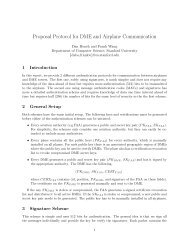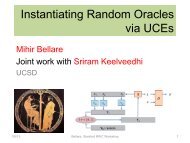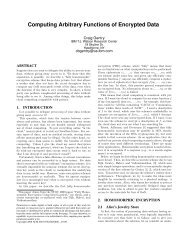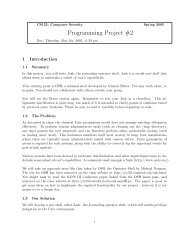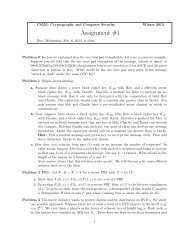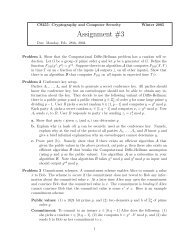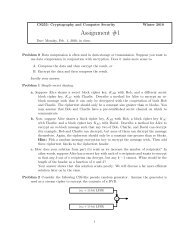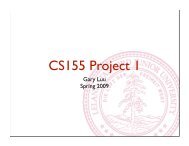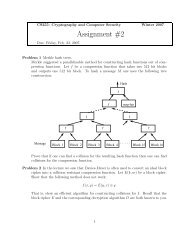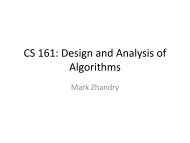Auditing SQL Queries - Stanford Crypto Group - Stanford University
Auditing SQL Queries - Stanford Crypto Group - Stanford University
Auditing SQL Queries - Stanford Crypto Group - Stanford University
You also want an ePaper? Increase the reach of your titles
YUMPU automatically turns print PDFs into web optimized ePapers that Google loves.
seemingly innocuous queries as suspicious), we show in<br />
Section V that in conjunction with a specific set of forbidden<br />
views, it can nevertheless provide a very strong guarantee<br />
that would be sufficient in many practical scenarios when all<br />
we wish to protect is the associations between identifiers and<br />
private attributes. At the same time, the auditor is simple and<br />
works for a very large class of queries.<br />
In Sections VI and VII we summarize the relationships between<br />
the different auditors above and also draw a connection<br />
to another database mechanism for controlling access to data<br />
— namely determining query validity studied in [9], [14], [15],<br />
[13]. The connection is interesting in that ideally a database<br />
system would have both an auditing component as well as an<br />
access control component and it is important to understand the<br />
interaction between the two.<br />
Assumptions: The auditors that we design in the upcoming<br />
sections are able to exactly determine query suspiciousness<br />
only when they operate on duplicate-preserving SPJ<br />
queries and views where the SELECT clause does not contain<br />
distinct and multi-set semantics is used in projection.<br />
We drop the duplicate-preserving qualifier from here on, but<br />
it is assumed as a default. Our suspiciousness definitions,<br />
however, are independent of query semantics, and at the end<br />
of Section IV-B, we briefly consider the guarantees of our<br />
auditors when queries do have a set semantics.<br />
We allow queries with self-joins, but only consider forbidden<br />
views with no self-joins. For ease of exposition, we only<br />
show our results here for queries without self-joins. Unless<br />
otherwise stated, the results can be easily extended.<br />
Furthermore, we make some assumptions about the domain.<br />
Let C be the set of all columns (attributes) across all tables in<br />
the database. For any C ∈C,letdom(C) denote the domain<br />
of column C and let it be of size at least 2. Let dom(T ) denote<br />
the set of possible tuples for a table T that can be obtained<br />
by assigning constants from dom(C) for each column, C,<br />
in T . Thus the value that an attribute of a tuple can take is<br />
not constrained by the values of other attributes. A database<br />
instance is then a multi-set of tuples in dom(T ) for every<br />
possible T that occurs in the database. We next briefly review<br />
relevant past work in auditing.<br />
II. PRELIMINARIES AND RELATED WORK<br />
A. <strong>Auditing</strong> Aggregate <strong>Queries</strong><br />
The problem of auditing queries has been extensively studied<br />
in the context of statistical databases [5], [12], [3], [1],<br />
[4], [6], [11]. Statistical databases allow users to retrieve only<br />
aggregate statistics over subsets of its data. In this paper we<br />
consider only SPJ queries and our work is orthogonal to the<br />
body of work on statistical databases.<br />
B. Perfect Privacy<br />
In [8], [7] the authors consider the problem of ensuring<br />
“perfect privacy”: as a database system reveals various views<br />
of its data, does it disclose any information at all about a secret<br />
view that was required to be kept confidential. This work can<br />
also be cast in the auditing framework proposed in this paper<br />
— the secret view corresponds to the forbidden view in our<br />
scenario, the views of the data that were released correspond<br />
to queries that were answered and the privacy requirement<br />
results in a definition of suspiciousness for identifying queries<br />
that violated the requirement.<br />
Perfect privacy: Let D be a distribution according to<br />
which tuples of the database are drawn. A set of released<br />
views, Q, is said to respect perfect privacy of a forbidden<br />
view, V, if:<br />
PrD{V = V } = PrD{V = V |Q}<br />
PrD{V} is the prior distribution over the forbidden view<br />
and PrD{V |Q} is the posterior distribution given the released<br />
views. Perfect privacy is very strict and results in the following<br />
criterion for query suspiciousness (referred to in this paper<br />
as perfect privacy suspiciousness) for distributions D where<br />
each tuple is included in the database independently with some<br />
probability and queries and views follow set semantics:<br />
Definition 1: (Critical Tuple) A tuple t belonging to the<br />
domain of all possible tuples in the database, is critical for<br />
a query Q, if there exists a possible database instance I for<br />
which Q(I −{t}) = Q(I), i.e., if there exists an instance in<br />
which dropping t makes a difference to the result of Q.<br />
Definition 2: (Perfect Privacy Suspiciousness) A query<br />
batch Q is suspicious with respect to a view V iff some query<br />
Q ∈Qis suspicious. Furthermore Q is suspicious with respect<br />
to to V iff there exists some critical tuple common to both V<br />
and Q.<br />
Disclosure detection guarantee: When queries are audited<br />
under perfect privacy suspiciousness, an unsuspicious<br />
query batch is guaranteed to respect perfect privacy of the<br />
forbidden view, whereas a suspicious query batch violates<br />
it. Even though this guarantee is shown to hold only under<br />
set semantics and for data distributions where a database<br />
instance consists of a set (not a multi-set) of tuples drawn<br />
independently of one another, we still treat it as a candidate<br />
notion of suspiciousness for duplicate preserving queries. We<br />
do not make any claims of its guarantees in this setting. Perfect<br />
privacy suspiciousness is very strict, marking many seemingly<br />
innocuous queries as suspicious. For example:<br />
Consider a hospital database containing the names and<br />
phone numbers of patients and we wish to keep secret<br />
all phone numbers in the database, i.e., the secret view is<br />
πphone(P atients). A query, πname(P atients), asking for the<br />
names of all the patients in the hospital would be considered<br />
suspicious with respect to the secret view even though not<br />
a single phone number was revealed by this query. This is<br />
because every possible tuple in dom(P atients) is critical<br />
to both the query and the secret view. The idea is that by<br />
revealing information about the size of the database, the query<br />
revealed some information about the phone numbers column<br />
and is considered suspicious.<br />
In [7], the authors identify subclasses of conjunctive queries<br />
without inequalities (≤,,=), following set semantics,<br />
for which checking for perfect privacy suspiciousness



